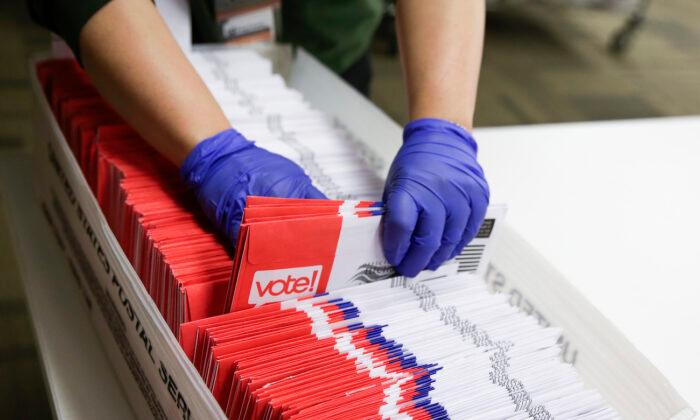One robot dog armed with a thermometer: $150,000.
Forty all-terrain vehicles, five utility terrain vehicles, and 18 utility trailers: $626,000.
Using public funds earmarked for coronavirus relief to buy these items: priceless.
That’s just a fraction of supposedly COVID-related spending by a single police department, in Honolulu, Hawaii. But it hints at what authorities will find as they begin to comb through the receipts from the emergency spending binge of public offices across the country during the pandemic.
In March 2020, Congress passed the roughly $2 trillion Coronavirus Aid, Relief, and Economic Security Act, or CARES Act.
Government watchdogs, critics and the media have so far focused on federal loans to businesses and unemployment scams, finding hundreds of millions of squandered dollars. Less scrutinized is how state and local offices themselves deployed the money. Also tapped were the emergency funds of some states, again opening the door to misspending that will be examined in the coming months.
Already, early examinations by state auditors are exposing spending carelessness and abuses.
In Michigan, auditors compiled a summary questioning $10 million in spending between March through August 2020. The probe found insufficient documentation for purchases of masks, beds, and face shields, a $321,000 payment to a state university unrelated to COVID, $5.1 million paid to a vendor after a contract was canceled, and an unspecified loss from a $5.5 million order for medical gowns.
As the coronavirus pandemic unfolded in March 2020, Michigan in an emergency move wired $96.9 million for personal protective equipment to vendors before the gear was received, in violation of prescribed financial procedures.
While conducting one such transaction, a vendor’s bank cautioned Michigan that the relevant account was “flagged,” according to the state audit, without going into further detail. The state ignored the warning and proceeded with a $4.9 million transfer. The vendor immediately initiated a “large cash withdrawal” of the money, according to a state audit. Michigan had been swindled. While it was able to recoup most of the money, it took a $25,000 loss.
Under Democrat Governor Gretchen Whitmer, Michigan has combined some of the most onerous coronavirus-based restrictions in the U.S. with some of the highest infection rates. But it’s not unusual among states in managing to misuse taxpayer money.
Oregon received $1.6 billion in CARES money, and its audit office in October noted that one small city, unnamed in its report, requested reimbursement for payroll costs related to the virus for as much as other cities “five to six times its size, even though the USA Facts data indicates its county’s COVID-19 incidence rate is relatively low.”
Oregon’s audit office also found that several cities used CARES funding to cover their entire law enforcement and public health payrolls. The state’s office of inspector general, which would normally investigate such practices, “appears to have settled on this approach being allowed as an ‘administrative convenience’ with no documentation required beyond substantiation of position and payroll costs,” the review stated.
In California, State Auditor Elaine Howle in an August note to Gov. Gavin Newsom and several state lawmakers said the spending of its $15.3 billion in CARES Act funds was at “high risk” for fraud and misuse.
The CARES Act money the state was given, she said, was being managed by 18 departments, some of which had previously botched handling federal money.
“These past audit findings highlight issues with departments’ abilities to manage federal funds appropriately even before the significant influx of federal COVID‑19 funding,” Howle wrote.
In Vermont, State Auditor Doug Hoffer sent a written appeal in June 2020 to the head of appropriations in each state chamber, seeking cooperation in tracking the spending of the $1.2 billion in CARES Act funds allocated to the state. “I understand the desire to get aid to Vermonters, but I’m concerned that the Legislature’s COVID-19 spending proposals lack sufficient accountability provisions,” Hoffer told the officials.
The $150 billion in collective federal CARES relief to the states came with seemingly straightforward instructions: Spending had to relate directly to COVID-19; it could not be part of any budget approved before March 27, 2020; and costs had to have been incurred in the calendar year 2020. A Dec. 30, 2020, deadline to spend the money was ultimately extended to year-end 2021.
But to some state lawmakers and agencies, the instructions were open to interpretation. This was reflected even in widely varying rules concerning the mere tracking of the spending itself, which appears in some cases to have been done haphazardly. A review of audits conducted within various states reveals widespread unmonitored spending.
Michigan auditors blame a lack of preparedness for the poor performance.
“The purchasing environment during this time was chaotic and, if not cautious, there was a huge amount of risk for fraud,” Christyn Herman, a spokeswoman for the Michigan Department of Technology, Management, and Budget, which oversees spending, said in an email. “Unknown vendors, distributors, and manufacturers were entering the market with products that we needed. Our team vetted each new lead and performed reference checks with known, reputable sources before moving forward on any transaction.”
But RealClearInvestigations faced delay and resistance to its routine request for records related to the $25,000 loss to the vendor, even though the state previously provided the records to the auditor. In response to a Freedom of Information Act request, the Department of Technology, Management, and Budget claims it will take 19 hours to retrieve the records, and asks for $596 to re-conduct the search.
The Center for Public Integrity, an investigative journalism organization, has deemed Michigan one of the worst states in the U.S. with regard to transparency. The state auditor’s office and the governor’s office did not respond to emails seeking an interview.
Auditors in other states expressed concerns about the accounting of COVID money early on in the pandemic.
A financial review by the Hawaii auditor’s office reported in October that the state’s Department of Budget and Finance allowed the agencies and offices that received Hawaii’s $1.2 billion in federal COVID relief funding to police themselves in spending it.
“We have strong reservations about delegating such oversight to the departments and counties,” State Auditor Leslie Kondo wrote in his report.
His fears were realized with the discovery that the Honolulu Police Department spent part of its $16.5 million in CARES Act money on some 100 new vehicles and the $150,000 robot dog. What did that dog have to do with the coronavirus? Deputy Police Chief John McCarthy told a local news outlet in an email that the battery-powered quadruped, called Spot, “will help to mitigate the spread of COVID-19 through touchless field screening and interaction with homeless individuals in self-quarantine.”
Kondo said his office had offered to help coordinate spending of the CARES Act money, but was rebuffed. The Budget and Finance Department “thought they had it under control,” Kondo said. “But there was this scramble to spend and distribute this money and we wanted to do some real-time audit work to make sure there were controls in place.”
Most other states have yet to scrutinize their spending. Still others claim to be tracking spending, but show little effort at assessing the content of it—that is, whether and which transactions may have been wasteful or fraudulent.
West Virginia’s auditing office states on its website that it is monitoring the spending of relief funds, but has done no audit of the money. Other states have established portals, in select cases allowing the public to see who the recipients are. While the portals allow taxpayers to know where the money went, they fail to disclose whether the money was used for its intended purpose.
Hoffer, the Vermont auditor, suggests that beyond the problems of tracking, politicians could naturally have assumed that the strings that came with the federal funding were loosely tied. “To say it has to be related to COVID sounds simple, but put some lawmakers together and they say, ‘Wow, all this money. Can we use it for X?’” said Hoffer. He cautioned legislators to be watchful over spending the $1.2 billion in CARES Act funding the state received, or face consequences later on.
It could be months, even years, before any misspending is discovered, said Nathan Benefield, vice president of the Commonwealth Foundation, a right-leaning Pennsylvania-based think tank, “and if you have to pay it back, the state has to come up with revenue to do that.”






